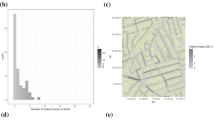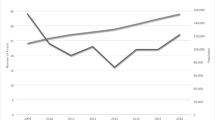Abstract
This study examines the effects of urban sprawl and population density on crime in suburban and rural municipalities. It is posited that population density provides additional context to macro-level crime research, potentially impacting the vitality of neighborhoods’ social institutions. Three models were created using data from the 2000 and 2010 US Census and Uniform Crime Reports for 142 municipalities, measuring the effect of municipal characteristics and population density on violent and property crimes. The results reveal that the traditional neighborhood characteristics measured in social disorganization research provide significant explanatory power for both measures of crime at the municipal level. Population density was found to have a significant negative relationship with property crime. A discussion and future research suggestions are presented to conclude.
Similar content being viewed by others
References
Battin, J.R. 2015. Collective efficacy theory and perceptions of crime: Documenting neighborhood context effects. El Paso, TX: LFB.
Brueckner, J.K., and A.G. Largey. 2008. Social interaction and urban sprawl. Journal of Urban Economics 64(1): 18–34.
Buonanno, P., G. Pasini, and P. Vanin. 2012. Crime and social sanction. Papers in Regional Science 91(1): 193–218.
Christens, B., and P.W. Speer. 2005. Predicting violent crime using urban and suburban densities. Behavior and Social Issues 14: 113–127.
Choldin, H.M. 1978. Urban density and pathology. Annual Review of Sociology 4: 91–113.
Cohen, L.E., and M. Felson. 1979. Social change and crime rate trends: A routine activities approach. American Sociological Review 86: 588–608.
Elliott, D.S., W.J. Wilson, D. Huizinga, R.J. Sampson, A. Elliott, and B. Rankin. 1996. The effects of neighborhood disadvantage on adolescent development. Journal of Research in Crime and Delinquency 33: 389–426.
Ewing, R., and S. Hamidi. 2014. Measuring urban sprawl and validating sprawl measures. Metropolitan Research Center. http://gis.cancer.gov/tools/urban-sprawl/.
Ewing, R., R. Pendall, and D. Chen. 2003. Measuring sprawl and its transportation impacts. Transportation Research Record: Journal of the Transportation Research Board 1831: 175–183.
Gibson, C., J. Zhao, N. Layrich, and M. Gaffney. 2002. Social integration, individual perceptions of collective efficacy, and fear of crime in three cities. Justice Quarterly 19: 537.
Harries, K. 2006. Property crimes and violence in United States: An analysis of the influence of population density. International Journal of Criminal Justice Sciences 1(2): 24–34.
Hawley, A.H. 1972. Population density and the city. Demography 9: 521–529.
Hemley, D.D., and L.R. McPheters. 1974. Crime as an externality of regional economic growth. Review of Regional Studies 4: 73–84.
Hindelang, M.J., M. Gottfredson, and J. Garofalo. 1978. Victims of personal crime. Cambridge, MA: Ballinger.
Hipp, J.R., and A. Roussell. 2013. Population density and crime: Micro- and macro-environment population and the consequences for crime rates. Social Forces 92(2): 563–595.
Jacobs, J. 1995. The uses of sidewalks. In In metropolis: Center and symbol of our times, ed. P. Kasinitz. New York, NY: New York University.
Kubrin, C.E., T.D. Stucky, and M.D. Krohn. 2009. Researching theories of crime and deviance. Oxford, NY: Oxford University Press.
Kvalseth, T.O. 1975. Statistical models of urban crime: A study of burglary. In Paper presented at the Joint National Meeting of the Operations Research Society of American and the Institute of Management Sciences, Las Vegas, Nevada.
Kvalseth, T.O. 1977. Note on effects of population density and unemployment on urban crime. Criminology 15(1): 105–110.
Li, J. and J. Rainwater. 2000. The real picture of land-use, density, and crime: A GIS application. http://proceedings.esri.com/library/userconf/proc00/professional/papers/pap508/p508.htm.
Maimon, D., and C.R. Browning. 2010. Unstructured socializing, collective efficacy, and violent behavior among urban youth. Criminology 48: 443–474.
Mazerolle, L., R. Wickes, and J. McBroom. 2010. Community variations in violence: The role of social ties and collective efficacy in comparative context. Journal of Research in Crime and Delinquency 47(1): 3–30.
Nolan, J.J. 2004. Establishing the statistical relationship between population size and UCR crime rate: Its impact and implications. Journal of Criminal Justice 32: 547–555.
O’Brien, R. 1983. Metropolitan structure and violent crime: Which measure of crime. American Sociological Review 48: 434–437.
Reiman, J. 2001. The rich get richer and the poor get prison: Ideology, class, and criminal justice. Boston, MA: Allyn and Bacon.
Roncek, D.W. 1981. Dangerous places: Crime and residential environment. Social Forces 60(1): 74–96.
Sampson, R.J. 1983. Structural density and criminal victimization. Criminology 21(2): 276–293.
Sampson, R.J., and W.B. Groves. 1989. Community structure and crime: Testing social-disorganization theory. American Journal of Sociology 94: 774–802.
Sampson, R., S. Raudenbush, and F. Earls. 1997. Neighborhoods and violent crime: A multilevel study of collective efficacy. Science 277: 918–924.
Sampson, R.J., and O. Wikstrom. 2007. The social order of violence in Chicago and Stockholm neighborhoods: A comparative inquiry. In Order, conflict, and violence, ed. S.N. Kalyvas, I. Shapiro, and T. Masoud. Cambridge: Cambridge University Press.
Silva, B. 2014. Social disorganization and crime: Searching for the determinants of crime at the community level. Latin American Research Review 49(3): 218–230.
Skogan, W.G. 1974. The validity of official crime statistics: An empirical investigation. Social Science Quarterly 54: 25–28.
Taylor, R.B., B.A. Koons, E.M. Kurtz, J.R. Greene, and D.D. Perkins. 1995. Street blocks with more nonresidential land use have more physical deterioration: Evidence from Baltimore and Philadelphia. Urban Affairs Review 31(1): 120–136.
Wells, W., J. Schafer, S. Varano, and T. Bynum. 2006. Neighborhood residents’ production of order: The effects of collective efficacy on responses to neighborhood problems. Crime & Delinquency 52: 523–550.
Zhang, H. and M.P. Peterson. 2007. A spatial analysis of neighbourhood crime in Omaha, Nebraska using alternative measures of crime rates. Internet Journal of Criminology 31: 1–31.
Author information
Authors and Affiliations
Corresponding author
Rights and permissions
About this article
Cite this article
Battin, J.R., Crowl, J.N. Urban sprawl, population density, and crime: an examination of contemporary migration trends and crime in suburban and rural neighborhoods. Crime Prev Community Saf 19, 136–150 (2017). https://doi.org/10.1057/s41300-017-0020-9
Published:
Issue Date:
DOI: https://doi.org/10.1057/s41300-017-0020-9




